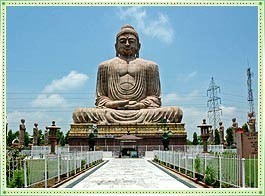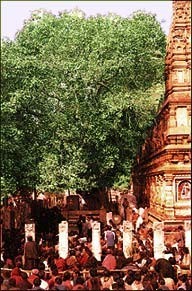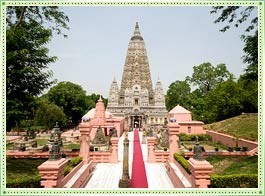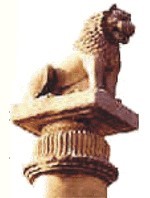Bodh Gaya or Bodhgaya (
Historically, it was known as the Bodhimanda (ground around the Bodhi-tree), Uruvela, Sambodhi, Vajrasana and Mahabodhi. The name Bodh Gaya did not come into use until the 18th century. The main monastery of Bodhgaya used to be called the Bodhimanda-
For Buddhists, Bodh Gaya is the most important of the main four pilgrimage sites related to the life of Gautama Buddha, the other three being Kushinagar, Lumbini, and Sarnath. In 2002, Mahabodhi Temple, located in Bodh Gaya, became a UNESCO World Heritage Site.
The surrounding town, by contrast, is dusty, noisy and somewhat polluted, due in large part to a lack of proper administrative structural coordination and rampant local corruption.[3] A new development plan has been proposed to “ensure a sustainable and prosperous future” for Bodh
Category: Tourist Place in Bihar
Tourist Places in Bodh Gaya

Bodh Gaya or Bodhgaya is a religious place in Gaya district in the Indian state of Bihar. It is famous for being the place of Gautama Buddha’s attainment of Enlightenment.
Historically, it was known as the Bodhimanda (ground around the Bodhi-tree), Uruvela, Sambodhi, Vajrasana and Mahabodhi.
(1) The name Bodh Gaya did not come into use until the 18th century. The main monastery of Bodhgaya used to be called the Bodhimanda-
For Buddhists, Bodh Gaya is the most important of the main four pilgrimage sites related to the life of Gautama Buddha, the other three being Kushinagar, Lumbini, and Sarnath. In 2002, Mahabodhi Temple, located in Bodh Gaya, became a UNESCO World Heritage Site.
(2) The surrounding town, by contrast, is dusty, noisy and somewhat polluted, due in large part to a lack of proper administrative structural coordination and rampant local corruption.
(3) A new development plan has been proposed to “ensure a sustainable and prosperous future” for Bodh
Bodh Gaya is the place where Gautam Buddha attained enlightenment under the sacred Asvatta tree (later termed Bodhi Tree). Buddhists all across the world consider the place the most sacred and this has become a pilgrim destination for them. Buddhists from all over the world have built temples here in Bodh Gaya. Bodh Gaya
Bodh Gaya houses a splendid and magnificent Mahabodhi temple and the temple has Bodhi Tree. Both the temple and the Bodhi Tree are sacred for Buddhists across the globe. The temple is an architectural amalgamation of many centuries, cultures, and
In the year 1953, Bodh Gaya revisited its glory. A new stupa with the help of Japanese governments’ donation was built in Gaya. Buddhists from Sri Lanka, Thailand, Myanmar, Bhutan, Korea, and Japan often visit
How to Reach Bodh Gaya:
Bodh Gaya is included in four most important pilgrim destinations where a Buddhist has to visit in
By Rail:
A good railway network connects Bodh Gaya with other major cities of India. A whole range of trains is available to reach Bodh Gaya. Gaya is the nearest railhead to Bodh Gaya at the distance of 17
By Road:
Besides a good network or railway tracks, Bodh Gaya is well connected by roads to various cities of India. The main bus stand is near Sujata Bridge on the bank of Falgu River on the northeastern edge of the town. Gaya is the nearest transport hub which is connected with Grand Trunk Road and from where you can catch direct
By Air:
Gaya is the nearest airport from Bodh Gaya. It is located at a distance of 17
Bodh Gaya Tourist Attractions:
Bodh Gaya, being the place where Gautam Buddha had learnt the eternal truth, is a popular tourist destination among Buddhists across the globe. There are a number of Buddhist monuments, temples and monasteries to see in Bodh Gaya.

Bodhi Tree
Contrary to general belief the existing Bodhi Tree is not the original Bodhi Tree under which
Gurpa
Gurpa is located forty
Mahabodhi Temple
The fifty meter high Mahabodhi Temple was built during the rule of the Guptas in the 5th century. This temple is considered among the oldest in Indian sub-continent temples.

Pragbodhi
Pragbodhi is the place where Lord Buddha spent some time before attaining enlightenment. The place is evidence of Gautam Buddha’s efforts toward the eternal truth.
Bodh Gaya Weather:
The city of Bodh Gaya is located at an altitude of 24º 41′ 45” N. Latitude and 85º 2′ 22” E. Longitude. Let’s have a quick look at the weather and climatic conditions of Bodh Gaya.
Places of Interest in Nalanda

Founded in the 5th century
BC, Nalanda was one of the world’s great universities and an important Buddhist
centre. When renowned chinese scholar and traveller Hieun Tsang visited Nalanda
between 685BC and 762BC, 10,000 monks and students resided here. Nalanda was
frequently visited by Lord mahavira and lord Buddha in the 6th century
BC.
Patna, 90 km away is the nearest airport. Nalanda can be reached by rail and
road from other major towns of Bihar.
Nalanda university archaeological complex
The entire excavation area stretches to around 14 hectares. The buildings are
divided by a central walkway that goes north to south. On either side of this
walkway one can find monasteries and temples. A small chapel retains a half
broken statue of the Buddha.
The Nalanda archaeological museum
This place houses the Nalanda university seal, sculptures and other remains
found at the site. It also contains a number of small Buddhist and Hindu
bronzes and some undamaged statues of the Buddha.
Nava Nalanda Mahavira
This is a relactively new institute, which is devoted to the study of pali
literature and buddhism. A number of foreign students come here to study.
Hieun Tsang memorial hall
One of the newest buildings here, it was built as a peace pagoda by the
chinese. Hieun tsang spent 5 years here as student and teacher.
Places of Interest in Vaishali
As long ago as the 6th
century BC, Vaishali was the capital of a republic. it is credited with being the
world’s first republic to have elected member of an assembly. Mahavira, the
founder of jainism, was born here, and the Buddha preached his last sermon
here. It also has a small musuem.
Regular bus services connect Vaishali to Patna (55 km). Nearest railheads are
Hajipur (35 km) and Muzaffarpur (36 km). Nearest airport is Patna.

The Lion Pillar at Kolhua, was built by Emperor Ashoka. It is made of a highly polished single piece of red sandstone, surmounted by bell shaped capital, 18.3m. high. A life-size figure of a lion isplaced on top of the pillar. The pillar is well-preserved and intact. There is a small tank here known as Ramkund. One can also find a few dilapidated stupas in Vaishali.
‘By reinventing Bihar Tourism, we hope to give a boost to the tourism sector’
Vinay Kumar IAS, director, Department of Tourism, Government of Bihar spoke to Joy Roy Choudhury of the dept’s major plans
What are the major tourism infrastructure development projects being implemented in the state now?
For the first time, a comprehensive Tourism Policy has been formulated and is being implemented. Tourism has been accorded the status of industry in the state, and a Tourism Protection Force shall be in existence very shortly. Very serious and planned steps have been taken to build, improve and renovate infrastructure. Selection and training of tourist guides are under way. A Tourism Enterprise Survey has been conducted with the assistance of Ministry of Tourism, Government of India. Two more studies, namely, Visitor’s Motivation Survey and Visitor’s Expenditure Surveys, are under consideration. Buddhist circuit roads are to be converted into four-lane highways with the cooperation from the Japan International Cooperation Agency. There are also plans for empanelment of travel businesses and complete overhaul of Bihar State Tourism Development Corporation (BSTDC). Major infrastructure projects include creation of meditation and convention centres in Bodhgaya and Rajgir, development of circumambulatory paths in Bodhgaya and Rajgir, development and beautification of all tourist sites, creation of new sites, and development of tourism-related roads and wayside amenities.
How are you promoting the Buddhist circuit in the state?
The Department of Tourism intends to promote, among others, the Buddhist heritage, the Jain circuit, rural tourism, the Sufi circuit, Gangetic and eco-tourism. Bihar Tourism believes that Bihar is to the Budhhists what Saudi Arabia is to the Muslims.
We organised a two-day International Buddhist Conclave in Nalanda in February this year in collaboration with the Ministry of Tourism, Government of India. Over 150 foreign delegates, mainly drawn from south-east and east Asian countries, were invited. We attend all major tourism events in the country and the London and Berlin events abroad. BSTDC has prepared special Buddhist packages which have been a hit. We hold Rajgir and Bodhgaya Festivals in the months of December and January which have become reputed. We are initiating negotiations with major airlines of Buddhist countries to bring regular and chartered flights to Bodhgaya. The Mahaparinirvana Express, run by the IRCTC, has been another powerful vehicle to bring tourists to the state.
The state government is advocating Public-Private-Partnership (PPP) to promote tourism in the state. Tell us about the major private-sector projects under implementation/on the anvil in the state.
As I mentioned earlier, tourism enjoys the status of industry in the state and by virtue of it all major policy concessions and exemptions are available to tourism ventures of the private sector. An important example of private-public partnership is the Ganga Cruise, which is quite popular among foreign tourists. Another such partnership in the making is setting up of star-category hotels on properties of BSTDC on long-term lease basis.
How are you planning to position the state as a favourable tourism destination for both domestic and foreign tourists?
Bihar currently receives about four and a half lakh foreign tourists every year. By reinventing Bihar Tourism, improving the infrastructure and building up the brand image, we hope to give a boost to the tourism sector.
Bihar Government has been trying hard to provide employment opportunities to the educated unemployed youths of the state. Selection and training of guides is one important initiative. Promotion of various tourism enterprises in hotel and restaurant businesses will be the main focus of the government.
Gaya – A Main Tourist Attraction of Bihar
Summary
District – Gaya
Headquarter – Gaya
Sub-Division – Gaya Sadar, Sherghati, Tekari
Population – 26, 64,803 (27 Lacs)
Area – 4,941 Sq. Km
Sea Level – 113 Meter
Temperature –
Summer: 46°C – 18°C
Winter: 20°C– 4°C
Best Season – November – February
Road Route – 112 Km from Patna
Rail Route – Main Railway Station – Patna, Gaya
Nearest Railway Station – Gaya (16 Km),
(458 km from Kolkata; 220 km from Varanasi; 589 km from Puri)
Air Route – Main Airport – Patna
Nearest Airport – Gaya
Main Spots of Tourist Interest
- Brahamyoni Mountain
- Dungeshwari Mountain
- Rock-cut-Sculpture of Kauodol Hills
- Ruins of Buddhist Monastery Hills Base & Buddhist Temple
- Ruins of Buddhist Monastery, Top of Kauodol Hills
- Gaya Museum
Histrocial Importance
Situated on the bank of river Falgu, Gaya is one of the ancient city in India. In Gaya only Bramhayoni and Dungeshwari Hills are related to Buddhist Circuit, where Lord Buddha came before his enlightenment, in search of Nirvana.
Today Gaya is mainly known as for Hindu circuit. Gaya is recognised as a holy city from ancient period. According to legend, Lord Vishnu endowed a celestial being named Gaya with the powers to absolve from sin all those who approached him. The devine Gaya was also empowered to raise the devout to the heavens so that they might join their ancestors. On the bank of river falgu very large number of pilgrims offer Pindan (Funeral cakes) at the ghats and perform a lengthy circuit of holy places around Gaya, to free their ancestors from bondage to the earth.
Places of Tourist Interests
Brahmayoni Mountain
Location: Brahmayoni hill is situated 1 km south of Vishnupada temple and its description is found in BuddhistBrahmayoni Mountain literature. To reach Brahmayoni hill one had to ascend 424 steps.
Importance: In Brahmyoni Mounain range there are 3 mountain peaks. Middle mountain peak in related to Buddhist Circuit & Right side Brahmayoni Mountainmountain peak is related to Hindu circuit.
Before enlightenment Gautam Buddha spent few days on this mountain, from this place Buddha reached the Sujata Place (Now in Bakraur, Bodhgaya) & from this place went to Dungeshwari Hills & then Bodhgaya to sit under Bodhi tree.
Now on this holy place we can see Ashoka stupa, a huge statue of Lord Buddha and Holy footprints on the hill. It is believed that ‘Ashoka the Great’ had got constructed a stupa here in the memory of Lord Buddha.
There are two interconnected narrow caves on the hill —Brahmayoni and Matriyoni. There is a belief that if one passes through the caves he would become free from the cycle of life and death.
Bihar Government has marked Brahmayoni hill as a ‘protected monument’. On the middle of peak there is an Ashokastupa and on its right temple of Brahma temple have been set up.
Dungeshwari Mountain
Location: Near to Bakraur (Sujata Place) on the other bank of falgu river, 32 km from Gaya, on the Gaya – Jamuawa – Surhari More- road route.
Importance: Lord Buddha came here from Sujata Place. On this place ‘devine powers’ suggested him to go to Bodhgaya for enlightenment. This mountain was known as ancient ‘Pragbodhi mountain’.
On the top of the mountain there are 7 ruins of Ashoka stupa. In the middle of the mountain, there is a Buddhist Temple & Hindu Temple, attract large no. of tourist on this holy place.
Rock-Cut-Sculptures of Kauvadol Hills
Location: Kauvadol Hills in 32 km far from Gaya District Headquarter, 20 km from Bela & 6 km from south-westRock-Cut-Sculptures of Kauvadol Hills Barabar caves (Jehanabad). Kauva Dol Hills is situated about a mile south-west of Barabar Hills, situated north-east of Belaganj block.
Importance: From the mound here remains of an ancient temple have been found. From the base of Kauadol mountain a large number of stone idols of Hindu god and goddess have been found. A ‘Gaumukhi Shivalinga’, a ‘Bansha bull’ considered to be carrier of Lord Shiva, has been found from the base of the mountain near tomb of Pir. It is believed that Kauadol (Kurisarai) was a town of Northern Gupta period (6-7th century BC) and it was named as Shramanpur. Chinese traveller Rock-Cut-Sculptures of Kauvadol HillsHieun-Tsang had mentioned ‘Shilbhadra Mahavihar’ which is believed to be at this place only. ASI-Branch-3, Patna team has expressed hope that here remains of Northern Gupta period to mid-term might be found.
On the rocks of the northern and eastern face of Kauva Dol Hill, numberous figures representing mostly Hindu deities like Hara-Gauri, Mahishasuramarddini Durga, Ganesa etc. A few figures of the seated Buddha are also noticed viz of Vajrasattva, Prajnaparamita and a seated Buddha. The sculptures may be assigned to a period between 800 to 1200 A.D. At Barabar Hills the passage leading to the Holy ‘Siddheshwarnath temple’ are ancient rock cut sculptures or Shiva Linga, Shiva Parvati, Ganesha etc. The image of the goddess Durga are how ever largest in number at Kauva Dol Hills. the four armed Durga slaying the buffalo demon Mahishasura. Other Brahmanical Figures are also noticed.
Ruins of Buddhist Monastery Hills Base & Buddhist Temple
Location: Kauvadol Hills in 30 km far from Gaya District Headquarter, 20 km from Bela & 6 km from south-west Barabar caves (Jehanabad). Kauodol is situated north-east of Belaganj block. Ruins of Buddhist Monastery is situated in the base of Kauva Dol Hills which is situated about a mile south-west of Barabar Hills.
Importance: It is considered important for its archaeological finds. In the 4th century BC it was a ‘training centre’ for young Buddhist monks, who were called ‘Shamner’. During that period this was training centre for not only Magadh area but for whole central area. In the 4th century BC Sramanpur was a township.
At the base of the Kauadol hill archaeological remains can still be found. According to historian Wenglar, the place was sanctum sanctorum of the temple — where one mandap, a semi-mandap and a maha-mandap existed. Till 1902 here 13 mandap existed and now only 9-10 mandap could be seen. Kauva Dol has been identified as the site of the ancient ‘monastery of Silbhadra’. This place was visited by Hiuen-Tsang in the 7th century. The Bodhisattva touched the earth when Mara challenged him. Exhorting the Earth goddess to appear to witness his enlightenment. Following excavation by the ASI and Bihar ASI, an eight-feet statue of Lord Buddha could be found in ‘Bhoomisparsh’ (ground-touching) posture.
Buddhist Temple – Near Buddhist Monastery, Kauvadol
Location: Kauvadol Hills in 32 km far from Gaya District Headquarter, 20 km from Bela & 6 km from south-westBuddhist Temple,Kauvadol Barabar caves (Jehanabad). Kauodol is situated north-east of Belaganj block and the base of Kauadol hill. Buddha Temple is situated in the base of Kauva Dol Hills which is situated about a mile south-west of Barabar Hills
Importance: The colossal image of Lord Buddha in Bhumi-sparsamudra is of Silbhadra monastery. Silbhadra was a learned Buddhist of the royal family of Samatata.
This is one of the largest satues of Buddha extant and is in fair preservation except that a portion of the halo has been broken the figure is about 8 feet high with a breadth of 4 feet across the shoulders and 6 feet across the knees.
Ruins of Buddist Monestery, Top of Kauvadol Hills
Location: Kauvadol Hills in 32 km far from Gaya District Headquarter, 20 km from Bela & 6 km from south-westTop of Kauvadol Hills Barabar caves (Jehanabad). Kauodol is situated north-east of Belaganj block. Ruins of Buddhist Monastery is situated on top of Kauva Dol Hills which is situated about a mile south-west of Barabar Hills
Importance: Beside one of the mountain hills of Kauvadol, on the top, there is ruins of Buddhist monastery. Several stones pillars, parts of doorway are seen hither & thither on the top of hill & near to top.
Gaya Museum
Location: Situated in the heart of the town of Gandhi Maidan, Gaya.
Importance: The museum has been declared as Gaya Museum-cum-Magadh Cultural Centre with a view to collect, display and make available all the relevant information regarding living cultural heritage of the region under one roof.
The museum preserves about 2000 antiquities of varied nature. The rich collection of stone sculptures especially of Pala period is rare and outstanding. Besides, the Museum also possesses a good collection of coins of different periods (punch marked to medieval